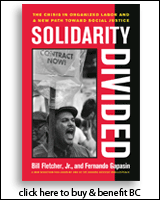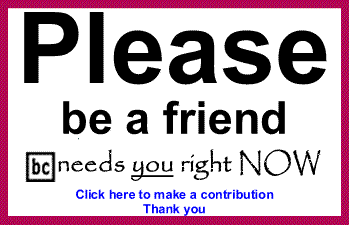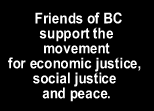
|
||||||||||||||||||||||
 |
||||||||||||||||||||||
 |
||||||||||||||||||||||
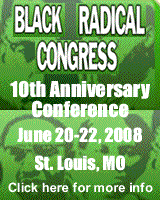 |
||||||||||||||||||||||
 |
||||||||||||||||||||||
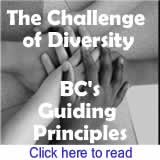 |
||||||||||||||||||||||
 |
||||||||||||||||||||||
 |
| The current issue is always free to everyone |
|
|
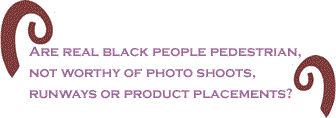 |
What’s up with all the olive-skinned, spiral-curled, hazel-, blue- and green-eyed folks standing in for black people in commercials and print advertisements these days?
Well, we have Alek Wek, but arguably she’s been positioned for aesthetic shock value, a safari on legs.
A few pages over, my fingers landed on an ad
for Just for Me hair products, featuring a little girl with
a wet-n-wavy ‘do and beige flesh, who looked primed for plessage,
a la 19th-century New Orleans. A few minutes later, I turned on the TV and shook my head as I saw the new McDonald’s “Cha Cha Slide” commercial, featuring a bright-skinned boy with Duke kit hair, who somehow just doesn’t fit in with his clearly black mom, dad and sister at the kitchen table. It’s becoming brow-raising to see basic browns, deep onyxes, cool cocoas and caramels coloring the skins of fashion and product models strategically hired to appeal to people like me – African-American, middle class, with at least a modicum of periodically disposal income. Missing in action are also the naps and kinks; I’m even beginning to miss the yaki and kinky-straight textures of recognizably native hair coaxed into submission.
Nowadays, the media reveals an unsettling spectacle – the systematic encroachment upon conventional blackness, as agents of racial ambiguity increasingly replace it. This is a new age, where appearances of trendy, cosmopolitan biraciality are subverting the apparently staid, boring baseline of the very blackness that injects the multiracial montage with the phenotypic flavor that the masses increasingly savor – that bend in the hair that produces the “perfect” wave, that blast of brown that gives way to tan-envied tawny.
But this is getting utterly ridiculous. BlackCommentator.com
Columnist
K. Danielle Edwards, a Nashville-based writer, poet and communications
professional, seeks to make the world a better place, one
decision and one action at a time. To her, parenting is a
protest against the odds, and marriage is a living mantra
for forward movement. Her work has appeared in MotherVerse Literary Journal, ParentingExpress, Mamazine, The Black World Today, Africana.com,
The Tennessean and other publications. She is the author of Stacey Jones: Memoirs of Girl & Woman, Body & Spirit,
Life & Death |
Any BlackCommentator.com article may be re-printed so long as it is re-printed in its entirety and full credit given to the author and www.BlackCommentator.com. If the re-print is on the Internet we additionally request a link back to the original piece on our Website. Your comments are always welcome. eMail
re-print notice
If you send us an eMail message we may publish all or part of it, unless you tell us it is not for publication. You may also request that we withhold your name. Thank you very much for your readership. |
|
| June
19, 2008 Issue 282 |
|
| Executive Editor: Bill Fletcher, Jr. |
| Managing
Editor: |
| Publisher: Peter Gamble |
| Est. April 5, 2002 |
| Printer Friendly Version in resizeable plain text format or pdf format. |
 |
 |
 |
| |
| |





















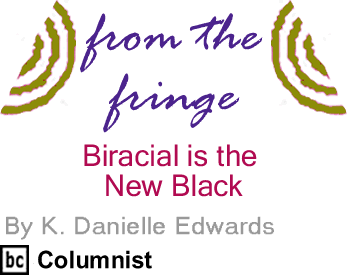
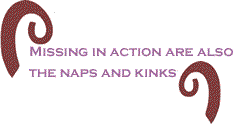 These
days, it’s ever rarer to see an ad for an “ethnic” hair product
or even so-called urban wear, while seeing someone who looks
remotely like me – honey-colored, nappy-haired, almond-eyed,
and leaving little question of which box I check – or gets
checked for me – on government forms. Flipping through a recent
issue of a popular black women’s magazine, in a Nivea lotion
ad, I spotted a lanky light-skinned lovely with a crown of
zig-zag curl #2, in the arms of a man who might be described
as tall, dark and handsome, but certainly not black.
These
days, it’s ever rarer to see an ad for an “ethnic” hair product
or even so-called urban wear, while seeing someone who looks
remotely like me – honey-colored, nappy-haired, almond-eyed,
and leaving little question of which box I check – or gets
checked for me – on government forms. Flipping through a recent
issue of a popular black women’s magazine, in a Nivea lotion
ad, I spotted a lanky light-skinned lovely with a crown of
zig-zag curl #2, in the arms of a man who might be described
as tall, dark and handsome, but certainly not black.
